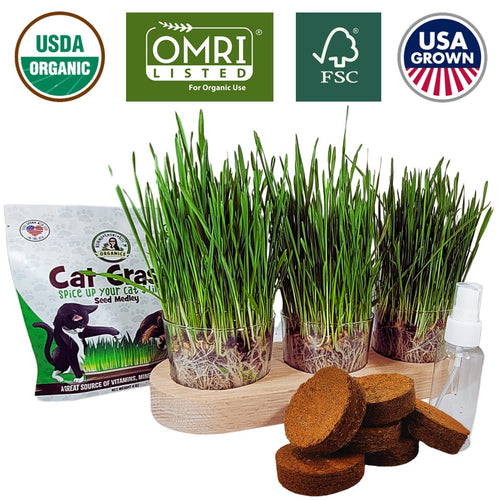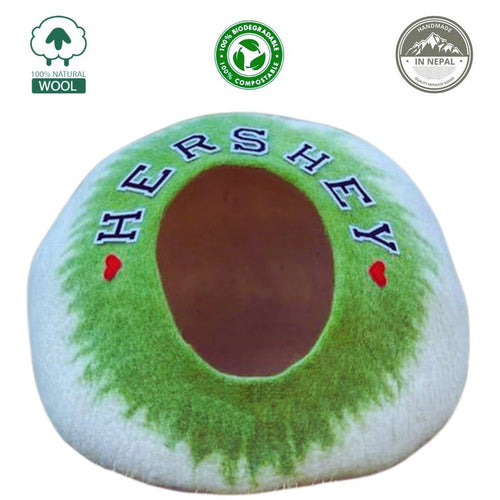Your Cart is Empty
Free 2-5 day delivery | No minimum purchase required
Free 2-5 day delivery | No minimum purchase required
Shop
Learn
Bengal Cat Guide: History, Health, and Personality Traits
 by K Marie Alto Updated
9 min read 2 Comments
by K Marie Alto Updated
9 min read 2 Comments

People looking to adopt a cat may be interested in any adorable feline that crosses their baths – and the Cat Distribution System is often happy to oblige. Other times, you may be more interested in adopting specific breeds.
Purebred cats are often quirky in their own ways, with breed characteristics that make them iconic in appearance, behavior, and personality. They can be an absolute joy! They can also be expensive, as pure breeds often end up prone to certain illnesses. They may not be for everyone, but for those who care for and love them, it's a great feeling knowing they're something special.
Among the many possible purebred cats out there is the Bengal. You've probably heard of them and seen their leopard-like appearance, and you wonder: is a Bengal cat right for you? I'm here to help you make that decision.
Table of Contents
What is the History of the Bengal Cat Breed?
Have you ever looked at a giant wild cat – a lion, a tiger, an ocelot, or a leopard – and thought, "Wow, I'd love to have one of those!" Unless you're a criminal, you can't, but a Bengal is the next best thing.
While Bengals share an appearance with certain wild cats, like the leopard, they have much more in common with our normal domestic felines. That's by design!
In fact, the Bengal is the result of a selective breeding program started in the 1960s by a woman named Jean Mill. Jean, like many of us, was fascinated by wild cats. On a trip to Southeast Asia, she saw the Leopard Cat – a relatively small wild cat native to the area.
The Asian Leopard Cat is about the same size as our domesticated cats. It's also a relatively friendly wild cat, as far as wild cats go – with archeological evidence suggesting that it was domesticated 5,000+ years ago in certain areas of China. The modern Leopard Cat is, of course, a wild cat, but the potential is there.

Leopard Cats are classified as Least Concern as far as endangerment as a species today, but back in the '60s, they were coming a lot closer to extinction due to poaching and fur trading. Kittens of the species were often sold as keepsakes, a sort of living souvenir, and Jean Mill bought one.
While the kitten Jean adopted – named Malaysia – was a solitary and skeptical animal, it did take to the partnership of a domestic black cat Jean also kept around, and in a twist that surprised many at the time, produced a viable kitten.
In any other story, you might think this would be an immediate turn to the goal of breeding cats, but Jean didn't take to it right away. It wasn't until 15 years later that she read a study about certain types of cats and cat cross-breeds that had an immunity to feline leukemia, including cross-breeds of leopard cats.
It was at this point that Jean started to work with those scientists to develop the species we now know as the Bengal. Her breeding incorporated elements of Leopard Cats and other breeds like Burma and Mau.
She faced many challenges, including hybrid males that ended up sterile (a common problem with near-species cross-breeds, like Mules and Ligers), but eventually produced the breed we know and love today.
What Are the Breed Characteristics of Bengal Cats?
What makes a Bengal a Bengal?
In most ways, Bengal cats are more or less the same as domestic cats. They may have some lineage of the wild cat, but their personalities are much closer to that of our lovable feline friends. The main thing the wild breeds add to the mix is the unique and striking fur coat.
Bengals look exotic. They're usually a shade of orange, ranging from faint orange to deeper, almost-brown orange. Their coat is mottled with spots like a leopard, with stripes on the legs and tail, all made of dark brown or almost black patches.

What does the F mean? Sometimes, when you're looking at Bengals, you'll see a label like "F4 Bengal" or "F2 Bengal" for the breed. The lower the number, the closer the cat is to the original wild cat in the lineage. It's a generational number!
Often, due to their more reclusive and hesitant natures, F1/2/3 Bengals aren't allowed (by state law!) to be generally adopted. F4 and higher tend to be much more outgoing and more like domesticated cats.
Over time, other varieties of Bengals have cropped up as well and been selectively bred by breeders and catteries around the world. Lighter, very pale versions are called Snow Lynx Bengals. Strikingly black-and-white cats are called Silver Bengals.
Blue Bengals have a blue-gray coloring that almost appears blue in the light. Some Bengals have the original black cat heritage and look almost pure black until their spots are revealed in the light. You can see an illustration here.
-
Lifespan: 10-16 years on average.
-
Coat: Short, though some long-hair Bengals, called Cashmeres, exist.
-
Energy level: High.
-
Attitude: Bold and affectionate.
In addition to their strikingly wild look, Bengals are ferociously playful, very social, vocal, and too clever for their own good. Get those child locks out and get ready to deal with a furry escape artist because a Bengal won't let anything stop them if they have places to be.
Training a Bengal Cat
Bengals are very intelligent, and they can learn quickly. They're very playful and interactive, and they have a lot of energy, so they really need a lot of stimulation and interaction to stay happy.
Basic cat training is often relatively easy with Bengals, and they pick up what you're putting down relatively quickly. Things like litter training, training them not to scratch the furniture, and training them out of certain behaviors (or into others) is quick and relatively painless.
Bengals can also learn some tricks. They can be almost dog-like in how responsive they can be to certain commands, and you can train a Bengal to sit, to come, to shake, or to jump. Just remember to use positive reinforcement and be consistent with your training!

One fun thing about Bengals is that they're actually pretty easy to harness-train. You can teach your Bengal how to happily wear a harness and leash, and then you can take them out for walks and explore just like you would a dog.
Bengals even enjoy water! Whether it's hopping into the bath with you or taking a dip in a pool or pond when you're out, they'll happily swim around when the mood strikes them.
When they're not getting into trouble or having fun, Bengals love to explore, and they are fantastic jumpers. If you're wondering where your Bengal is, check on top of the cupboards and shelves first.
And, at the end of the day, Bengals form close bonds with their parents and tend to be very affectionate.
Warning: If you're not able to spend a lot of time and energy on your cat, don't get a Bengal. They really need attention, play, and affection to thrive, and if you have to leave them alone for eight hours a day while you work, you're going to have a lot of issues with them. They will also get into anything and everything if they can, which can be dangerous if you haven't properly cat-proofed your home.
To sum it all up, Bengal cats are a bit much, in all the best and worst ways.
Do Bengal Cats Have Health Issues?
Purebreds of any animal tend to have health issues unless they're very, very carefully controlled, and even then, it's sometimes just an unavoidable fact of genetics. What about Bengals?
There's good news and bad news here.
The good news is that Bengals are considered a pretty healthy cat breed. Since the breed is new, and it wasn't developed until after we had a pretty good societal understanding of genetics (at least the basics), many of the common causes of health issues in purebreds aren't there.
You don't have the stubby snouts, the tendency for kidney issues, or the susceptibility to diseases that you get from breeds that were produced through hundreds of years of inbreeding.

Bengals do, however, have some tendencies. They are particularly prone to eye problems, including progressive retinal atrophy, cataracts (no pun intended), and an eyelid issue called entropion.
They are also more prone to cardiomyopathy and joint issues than your usual domestic feline. It's also possible that Bengals are more likely than other breeds to develop lymphoma.
Bengals are also generally extra-sensitive to anesthesia, particularly ketamine. This means a vet needs to know how to deal with the breed for procedures like surgeries, where their normal anesthetic protocol could risk severe side effects on a Bengal.
Some Bengals go their whole lives without any of these issues, while others develop them surprisingly young. The key is to know what to watch for and, if your cat experiences any of them, to know how to deal with it.
How to Care For a Bengal Cat
Bengals don't need a lot beyond what most cats need. They're generally short-haired, so you only need to brush them every few days. Their nails need to be trimmed and their teeth need care, but that's the same as any cat.
The areas where Bengals need more attention are energy, exercise, and mental stimulation. A little automatic toy that swings a feather around won't cut it. Bengals have very high energy levels, and they're very smart, so they do best when you can dedicate time to playing with them in ways that engage their mind, not just their body.

One thing to be careful of is that Bengals can be a bit fierce when they play, and they can be very skeptical of newcomers. They can become fast friends with other cats, dogs, children, and other pets. But, if they get overstimulated, they can lash out.
Their playtime can get surprisingly violent, too, and another animal that isn't used to or prepared for it runs the risk of getting hurt. That applies to people and kids, too.
Food puzzles, training, vertical playgrounds, and fetch are all good options to play with a Bengal. They also love watching the outdoors, so make sure they have a nice shelf or platform near a window.
Where to Find a Bengal Cat to Adopt
As a pure breed, Bengals can be difficult to find.
This is a difficult question to answer, and not just because I don't know where you're reading this from. I'm generally against breeders on principle because there are millions of loving and deserving cats out there in shelters who run the risk of being euthanized.
There are, however, dedicated purebred rescue organizations across the country. Groups like SPCR in the Midwest help to rehome purebreds of all breeds.
Breed-specific rescues like Bengal Rescue (which operates in the west and southwest) and their partners, Great Lakes Bengal Rescue, can also be good options. You can also use more generic services like Chewy or Petfinder, though you never know for sure who is on the other end of such sites.

Adopt, don't shop. That's the only ethical way to get a purebred cat these days, with so many looking for their forever homes when life has abandoned them.
And, yes, Bengals can be expensive. Specialty rescues tend to charge higher fees than your average local shelter through a combination of demand, issues with unscrupulous adopters, and more. Whether you're looking at $500 or $1,000 for a cat, it wouldn't be a surprise. Though, even that is still cheaper than a breeder, so it's a win, really.
If you can rescue a Bengal, and you have the time and attention to give them, you'll be rewarded with one of the most intelligent, affectionate, and incredible cats in the world. Otherwise, I'd recommend setting your sights a little lower and checking out your local shelter for someone to love for more than just the spots on their coat.
Do you have any questions about Bengal cats? If so, I'm always more than happy to help however I can, so be sure to leave me a comment down below!
The Future of Cat Care is Here - Ethical, Non-Toxic, and Sustainably Made Cat Supplies Made in the USA!
Your cat trusts you to make the best choices for their well-being. At toe beans, we take that responsibility seriously.
That’s why we make our own cat grooming supplies, pack our US-grown USDA certified organic cat grass, and design and manufacture our eco-friendly cat furniture with only the cleanest, safest, and third-party-certified materials the world has to offer. All right here, in the USA!
No harmful chemicals, no questionable ingredients, no “globally sourced ingredients”, no human exploitation, just pure, clean, ethical, sustainable American manufacturing quality.
We outright reject mass production shortcuts and the use of toxic raw materials and ingredients common in overseas manufacturing.
Instead, we work with carefully vetted suppliers, U.S. artisans, and small-batch producers (a few of them in the EU), ensuring ethical labor practices, strict material safety standards, and supply chain controls and oversight.
Because your cat deserves better. Shop toe beans cat supplies today.
K Marie Alto
K. Marie is an animal lover, wife, kitty mom, dog auntie, writer, and co-founder of Toe Beans, a proud American family-owned online boutique pet supplies store focused on the improvement of the life of furry family members via pet parent education, better products, and advocacy. She has over 20 years of experience as a pet momma. She loves sharing her personal journey and experience as a pet parent via her blog and Facebook page where she currently has more than 50K followers (@furrytoebeans) and counting :-). Read more
2 Responses
Cynthia Whipple
April 14, 2025
they are so pretty
Leave a comment
Comments will be approved before showing up.
Also in Pet Parents Blog by Toe Beans

The Guide to Dog Enrichment Toys for a Happier Pup
by K Marie Alto April 17, 2025 8 min read
Learn how enrichment toys can keep your dog happy and healthy, providing mental and physical stimulation even when you're not home in this comprehensive guide.

Techniques To Stop Your Cat from Begging While Eating
by K Marie Alto April 10, 2025 10 min read
Learn how to manage your cat's begging behavior during meal times with effective techniques that enhance comfort and ensure their safety, as well as yours.

The Truth Behind Zeus, The World’s Largest Great Dane
by K Marie Alto April 03, 2025 10 min read
Learn about Zeus, a gentle giant and therapy dog who holds the record as the world’s tallest Great Dane, showcasing his lovable nature and impressive stature.
Related Products

Cat Grass Growing Kit | Ultimate | USDA Organic Seeds | Grown in the USA
$34.99

Cat Books | Cat Parenting 101 | Paperback Format
$12.80

Cat Beds | Customizable Cat Caves
$29.99
Recent Articles
- The Guide to Dog Enrichment Toys for a Happier Pup April 17, 2025
- Techniques To Stop Your Cat from Begging While Eating April 10, 2025
- The Truth Behind Zeus, The World’s Largest Great Dane April 03, 2025
- Bengal Cat Guide: History, Health, and Personality Traits March 27, 2025
- How Can You Stop Your Dog from Licking Their Paws? March 20, 2025
- Why You Should Invest in Automatic Pet Water Fountains March 13, 2025
- Guide: The Ultimate List of Fruits That Your Dog Can't Eat March 06, 2025
- Is Your Cat in Heat? The Signs and What You Should Know February 27, 2025
- Dog Spay Surgery: What Symptoms Can You Expect After? February 19, 2025
- DIY Tips for Making Healthy Homemade Cat Food Recipes February 13, 2025

K. MARIE - TOE BEANS TEAM
April 14, 2025
Cynthia – I agree!